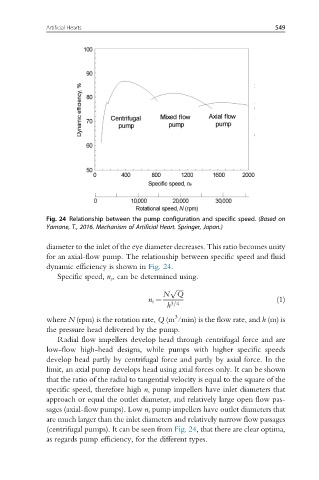Page 556 - Handbook of Biomechatronics
P. 556
Artificial Hearts 549
Fig. 24 Relationship between the pump configuration and specific speed. (Based on
Yamane, T., 2016. Mechanism of Artificial Heart. Springer, Japan.)
diameter to the inlet of the eye diameter decreases. This ratio becomes unity
for an axial-flow pump. The relationship between specific speed and fluid
dynamic efficiency is shown in Fig. 24.
Specific speed, n s , can be determined using.
p ffiffiffiffi
N Q
n s ¼ (1)
h 3=4
3
where N (rpm) is the rotation rate, Q (m /min) is the flow rate, and h (m) is
the pressure head delivered by the pump.
Radial flow impellers develop head through centrifugal force and are
low-flow high-head designs, while pumps with higher specific speeds
develop head partly by centrifugal force and partly by axial force. In the
limit, an axial pump develops head using axial forces only. It can be shown
that the ratio of the radial to tangential velocity is equal to the square of the
specific speed, therefore high n s pump impellers have inlet diameters that
approach or equal the outlet diameter, and relatively large open flow pas-
sages (axial-flow pumps). Low n s pump impellers have outlet diameters that
are much larger than the inlet diameters and relatively narrow flow passages
(centrifugal pumps). It can be seen from Fig. 24, that there are clear optima,
as regards pump efficiency, for the different types.

